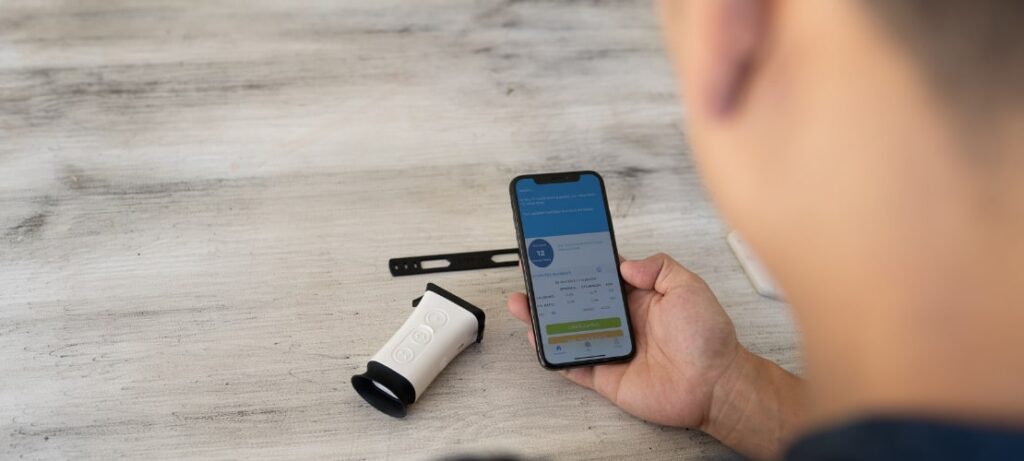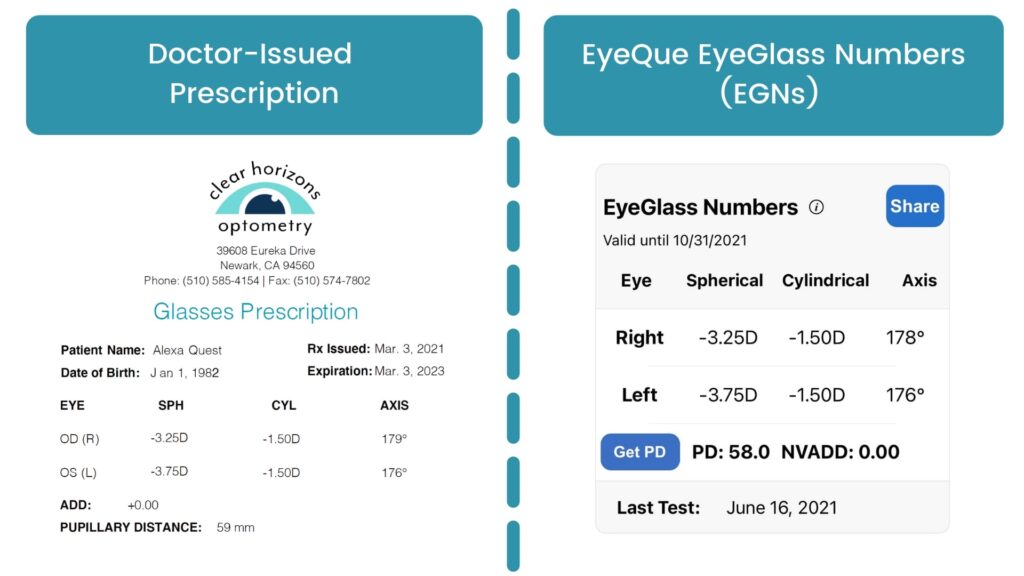
Do you need vision correction with eyeglasses or contacts? If you do, you probably have an eye prescription. Your eye prescription gives you the numbers you need to correct your vision. An eye prescription can only be dispensed by an eye care professional such as an optometrist or ophthalmologist. EyeQue EyeGlass Numbers (EGNs) are the results generated from taking a refraction test using the EyeQue VisionCheck. EGNs are displayed in the same format as your eye prescription so you can easily compare the two.

Your eye prescription typically has these elements:
Sphere
This is the amount of lens power, measured in diopters (D), prescribed to correct nearsightedness or farsightedness. If there is a minus sign (-), it means you are nearsighted. If there is a plus sign (+), it means you are farsighted.
Cylinder
If you have astigmatism, this is the lens power number to correct it. If you don’t have astigmatism or have very low levels of astigmatism, you won’t have a cylinder number.
Axis
The number for axis is the degree and direction of your astigmatism.
ADD
If you have presbyopia, you will have an ADD number to your prescription. ADD is the added magnifying power applied to the lower part of your glasses to correct for presbyopia. The number appearing in this section of the prescription is always a “plus” power, even if there is no plus sign.
PD
This is your pupillary distance. Pupillary distance measures the distance between the pupils of your eyes. Your PD measurement helps the eyeglasses manufacturer to align your prescription properly to your eyes.
How Do You Get EyeGlass Numbers?
EyeGlass Numbers are the results that you get from the EyeQue VisionCheck. EyeGlass Numbers are not an eye prescription. Once you complete a series of tests with your device, you will get a set of EyeGlass Numbers. It uses the same type of numbers and format as an eye prescription issued by an eye care professional so that you can easily compare the EyeGlass Numbers with your current prescription.
An example of an EyeGlass Numbers record looks like this:

What Can You Do with EyeGlass Numbers?
You can do a lot! You can track your vision over time, share your results with a loved one or your eye doctor, and even get a prescription online from a Telehealth professional. If you have any questions about your EyeGlass Numbers, feel free to contact us at support@eyeque.com so that we can help!
How Should You Compare Your EGNs to Your Last Prescription?
There isn’t one set of magic numbers. Optometrists generally consider agreement up to 0.5 diopters as acceptable. That means if you visited two different optometrists on the same day and they both issued you a prescription, the Spherical and Cylindrical numbers could vary by up to 0.5 diopters and still be considered accurate vision correction for you to see clearly.
Here are a few reasons why you may be seeing a difference larger than 0.5 diopters:
- Your prescription is outdated: Your vision has changed! That’s why you’re testing your vision from home between annual eye exams, right?
- It has a positive cylinder notation: While rare, some prescriptions are issued with a positive cylinder notation, rather than negative. If your last doctor-issued Rx contains a positive cylinder number (e.g. +0.50), you can convert it to the more common optometrist notation (which uses negative cylinder value) using this online tool. This way you can more directly compare your Rx to your EyeQue EGNs.
- You’ve had difficulty taking the test: If you haven’t been consistent with your test-taking (or you’ve let someone else use your account to test their eyes) you will see a large range or spread in your tests measurements, resulting in an inaccurate set of EyeGlass Numbers.
- Human error: Your prescription wasn’t properly transcribed or written accurately when issued.
Have a question or need more help? Find us at support@eyeque.com.
Take the Next Step: Order the VisionCheck
